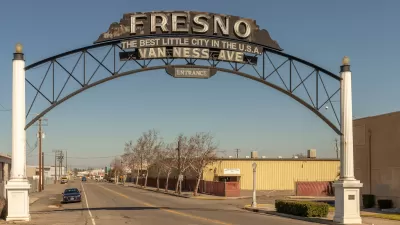Wounded but far from dead, the WSJ examines the many problems plaguing California's formidable HSR project. With federal funding likely to be pulled by House Republicans, the Journal reports on the courses the project could take.
To be sure, it's not just high speed rail-hostile House Republicans that the California High Speed Rail Authority must confront. Opposition in the Central Valley has forced unexpected increased costs for the Bakersfield to Fresno 140-mile stretch. The Authority's revised business plan, already delayed, is due by Nov. 1 and will be scrutinized by a wary state legislature, though the Democratic majority and the governor remain backers of the $45 billion project.
"The California troubles reflect the difficulty of shifting a country that mainly relies on the automobile and airplane. The federal government and states have for decades built and maintained roads using a dedicated revenue stream, the federal gasoline tax of 18.4 cents per gallon. There is no such source of cash for high-speed rail, putting rail proponents at the mercy of political winds."
California has to-date received $3 billion in federal funds, and matched it from the 2008 $9 billion bond measure. The remaining $6 billion can only be applied as matching funds.
"Roelof van Ark, chief executive of the California rail authority, said private investors, including rail operators and construction companies from Europe and Asia, have voiced interest in high-speed rail. The catch: Investors want to see a link to San Francisco or Los Angeles closer to completion before they put in billions, he said. It is precisely that link for which the state needs money."
FULL STORY: Plan for High-Speed Rail Just Inching Along

Alabama: Trump Terminates Settlements for Black Communities Harmed By Raw Sewage
Trump deemed the landmark civil rights agreement “illegal DEI and environmental justice policy.”

Planetizen Federal Action Tracker
A weekly monitor of how Trump’s orders and actions are impacting planners and planning in America.

The 120 Year Old Tiny Home Villages That Sheltered San Francisco’s Earthquake Refugees
More than a century ago, San Francisco mobilized to house thousands of residents displaced by the 1906 earthquake. Could their strategy offer a model for the present?

In Both Crashes and Crime, Public Transportation is Far Safer than Driving
Contrary to popular assumptions, public transportation has far lower crash and crime rates than automobile travel. For safer communities, improve and encourage transit travel.

Report: Zoning Reforms Should Complement Nashville’s Ambitious Transit Plan
Without reform, restrictive zoning codes will limit the impact of the city’s planned transit expansion and could exclude some of the residents who depend on transit the most.

Judge Orders Release of Frozen IRA, IIJA Funding
The decision is a victory for environmental groups who charged that freezing funds for critical infrastructure and disaster response programs caused “real and irreparable harm” to communities.
Urban Design for Planners 1: Software Tools
This six-course series explores essential urban design concepts using open source software and equips planners with the tools they need to participate fully in the urban design process.
Planning for Universal Design
Learn the tools for implementing Universal Design in planning regulations.
Clanton & Associates, Inc.
Jessamine County Fiscal Court
Institute for Housing and Urban Development Studies (IHS)
City of Grandview
Harvard GSD Executive Education
Toledo-Lucas County Plan Commissions
Salt Lake City
NYU Wagner Graduate School of Public Service



























